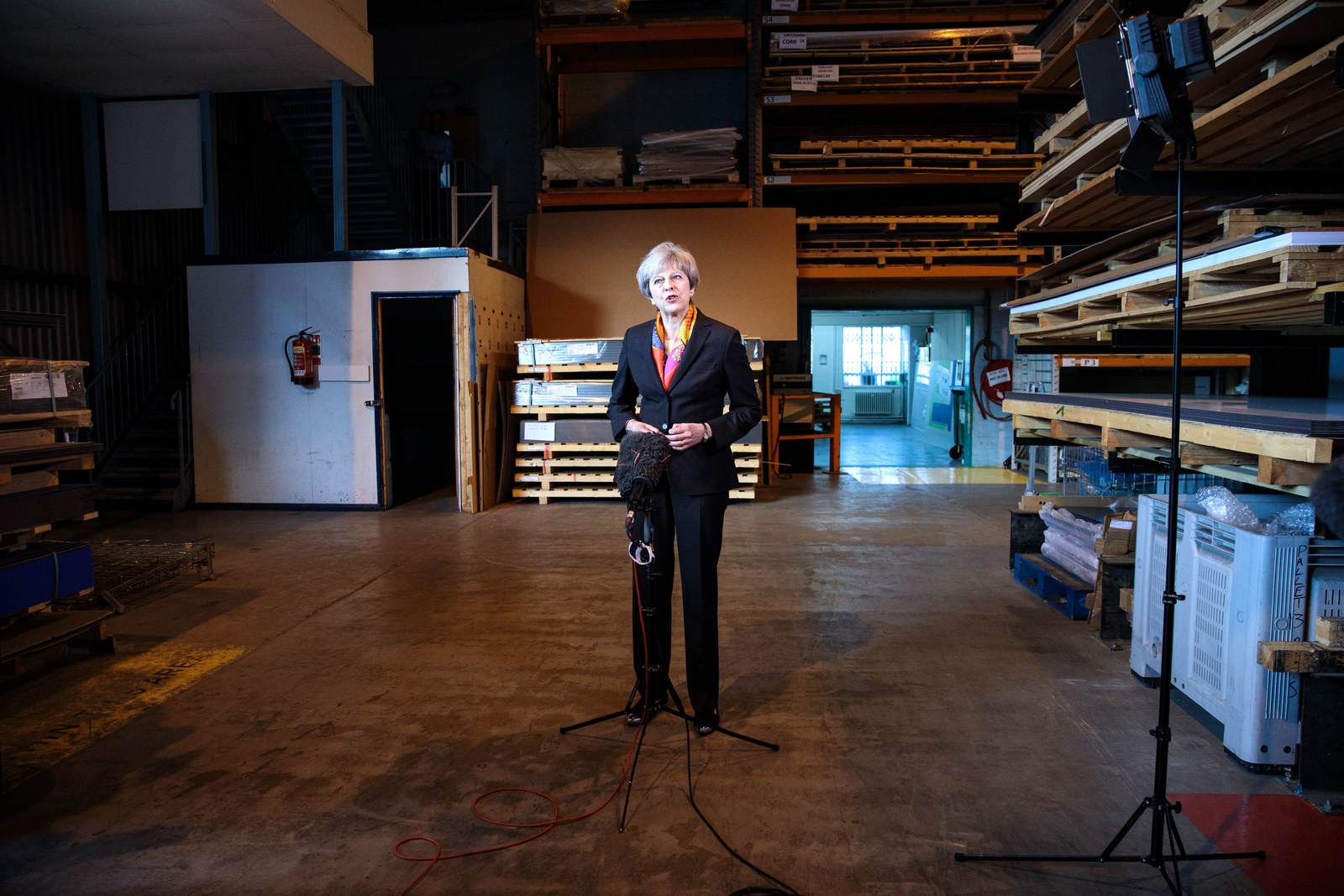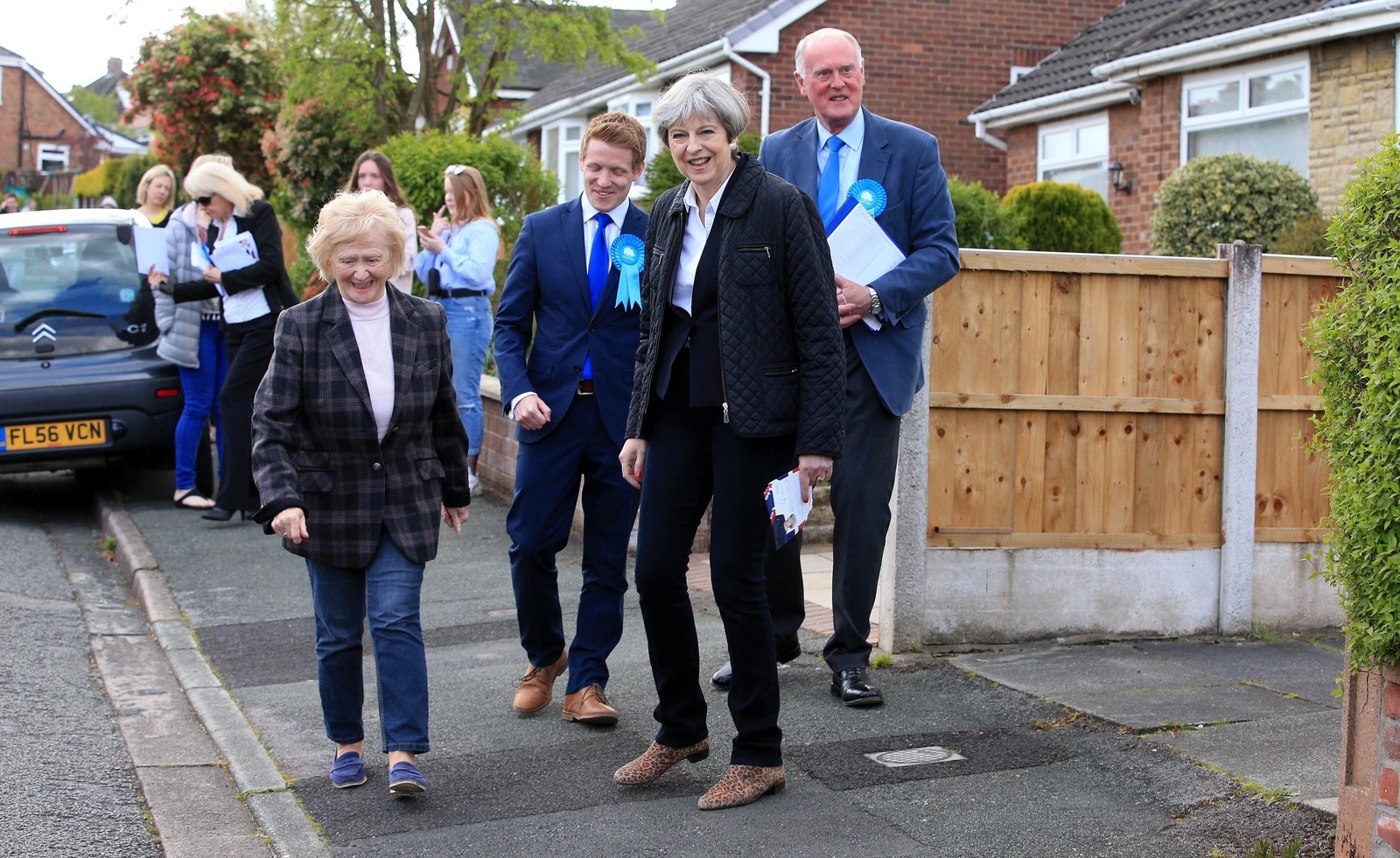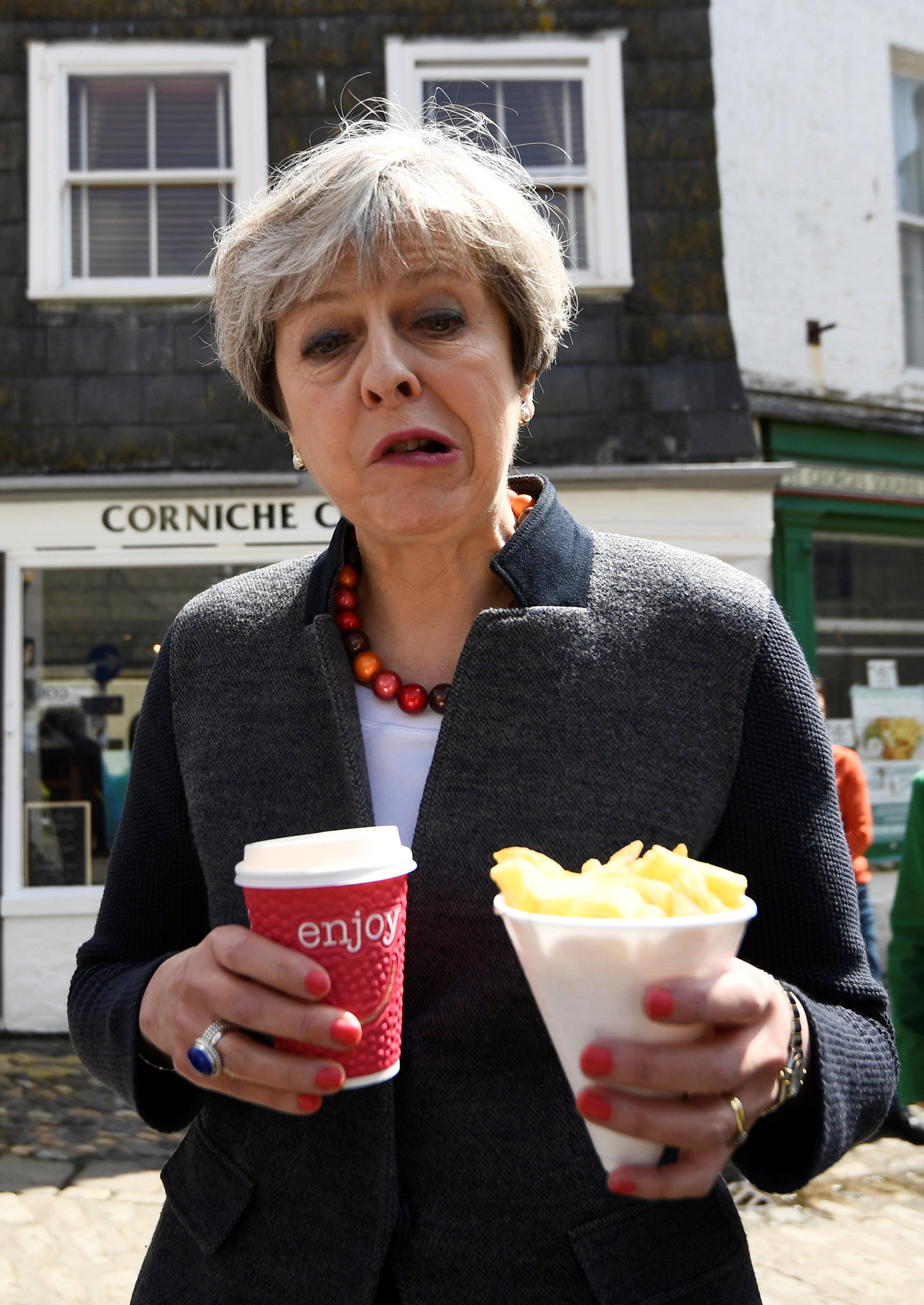A murmur ripples through the hall, then a cheer, as Theresa May appears on a podium in the centre of the room, surrounded by Conservative activists.
It’s a Tuesday night in Bristol, but it could be Leeds or Lancashire, Scotland or Wales – so far, the rallies have been virtually identical. A modest community centre. A crowd of about 100 party supporters pressed close together, clearly enthused. A bank of TV cameras, a small huddle of reporters. And behind the prime minister, a giant blue banner:
“THERESA MAY: STRONG, STABLE LEADERSHIP IN THE NATIONAL INTEREST.”
May doesn’t mess around with pleasantries. She gets straight to the point. With Brexit looming, the country is facing a historic moment. Voters have a grave choice: Who do they trust to lead them? “Will it be me and my team, showing the strong and stable leadership that our country needs? Or will it be Jeremy Corbyn, at the head of a coalition of chaos?”
May has approached the opening two weeks of her first national election campaign as Conservative leader in the same way she has operated in two decades in Westminster: competently, diligently, and with ruthless discipline.
It hasn’t been joyful to follow. It hasn’t been illuminating. It has told us almost nothing we didn’t already know about the woman who is virtually certain to become prime minister for another five years on 8 June – or what she intends to do with her enhanced power.
But get used to it. It’s working.

With an overwhelming lead over Labour in the polls, an experienced, trusted, battle-hardened team, and a party mostly united behind her, May has to do little more in the short, six-week election campaign than stay on message and avoid making any catastrophic blunders. Staying focused and not making mistakes is what May does. In British politics, there are few with a reputation for having a safer pair of hands.
“She’s good at holding the line and doesn’t screw up,” says Giles Kenningham, a former special adviser to David Cameron in 10 Downing Street who worked on the 2015 general election campaign.
This time, safety first may be all it takes.
By all accounts, May is on track for a landslide victory that will return her to Downing Street next month with a vastly bigger majority. Unencumbered by her predecessor's manifesto pledges, rebellious backbenchers, or parliamentary opposition, she will be free to pursue her vision for a provincial conservatism and an uncompromising Brexit – and she seems set to get there having been barely tested on the campaign trail.

The Tory activists wave placards and nod approvingly as May whips through her stump speech.
It’s an almost exclusively white, mainly grey-haired, blazers-and-chinos sort of crowd. Many seem to have travelled from elsewhere in the region to be here. “I think this is Bristol East, isn’t it?” one man in the audience says, when asked which constituency the venue is in. He's right: It is Bristol East, a seat Labour won with a majority of 3,980 in 2015 but which the Tories now have in their sights. It's one of dozens the party is targeting in areas of the country that once seemed beyond their reach.
The activists clap and shout “hear hear!” when May refers to the Tories’ bogeymen – the European Commission, the Liberal Democrats. They laugh when she talks about Jeremy Corbyn’s supposed incompetence and boo when she mentions the Scottish National Party.
“We must not be complacent,” May warns them. “We must go out and work for every single vote.”
Until a few weeks ago, May was adamant she didn’t want an election. For months, officials in Downing Street repeatedly, firmly denied that she would seek one, even though to many the logic for holding one seemed unassailable. "I have only recently and reluctantly come to this conclusion,” May said outside Number 10 on 18 April, the day she announced she would go to the polls.
It was on a walking holiday in Wales with her husband Philip a few weeks earlier that the prime minister dropped her resistance to the idea, she told ITV News.

May’s influential co–chief of staff and policy adviser Nick Timothy is understood to have been instrumental in convincing her to change her mind, arguing that it was "now or never". Opinion polls showed the Conservatives holding a double-digit lead over Labour in the polls, virtually guaranteeing a bigger mandate. A healthy parliamentary majority would mean her government would be less vulnerable to rebellious backbenchers and Remain-voting MPs who threatened to delay important Brexit-related legislation. Better to go now before the Brexit negotiations have started. Wait, and the political landscape will only get more complicated.
The U-turn caught out nearly everybody in Westminster – including at Conservative party HQ. “Central office was absolutely, definitely not ready,” says a Tory MP. “They had no candidates in place, no literature written.” But they moved quickly. Timothy and Fiona Hill, May’s other chief of staff, moved across to the campaign. (The pair worked for May when she was home secretary and are her closest, most trusted advisers, with huge influence across government. Timothy is pulling together the party’s policy manifesto, which may be published next week.)
Joining them in the war room at Conservative HQ are several veterans of Tory campaigns: Sir Lynton Crosby, the Australian campaign guru who masterminded the Conservatives' 2015 victory; Jim Messina, Barack Obama’s former campaign strategist, who is famed for his microscopic knowledge of voter data; Craig Elder and Tom Edmonds, the digital media experts; and Stephen Gilbert, a veteran campaign strategist who is chiefly responsible for moving the campaign chess pieces around day to day. (“This is Gilbert’s show,” Politico reported in a detailed piece about the inside of the campaign this week.)
Also in the team is Chris Wilkins, a veteran Conservative adviser who has a long history with May. Wilkins wrote May's famous speech to the party's annual conference in 2002, when she urged the Tories to shed their reputation for being “the nasty party”. He has been closely involved in writing her stump speeches.
They are a close-knit and tight-lipped group, refusing to talk publicly about strategy or tactics. There are few leaks. The atmosphere in campaign headquarters is businesslike and disciplined. Crosby may not be running the campaign day-to-day this time, but the overall messaging and strategy has been drawn from his playbook from previous campaigns. There are differences from Cameron's 2010 and 2015 campaigns. May's events are less ostentatious than those of her predecessor, the venues smaller and more intimate. And her campaign has so far not deployed the flashier gimmicks favoured by the Cameroons, like getting prominent businesspeople to write open letters to newspapers endorsing the party in the hope of underlining its economic credentials.
Yet it has been just as ruthlessly controlled. Two weeks in, close observers are already sick of the constant “strong and stable” message, accusing the Tories of running an unimaginative and "robotic" campaign, as Nick Clegg, the Liberal Democrat former deputy prime minister, who sat in Cameron's cabinet with May, put it. But that doesn't bother the party strategists. If political journalists and Twitter commentators are bored, so what? The only thing that matters is what the voters think.

The Conservatives have internalised an important lesson from Crosby: Most voters pay almost no attention to politics, goes Crosby's thinking. You might have to repeat something 1,000 times before it gets through to a disinterested voter. So you choose clear, simple messages, and push them relentlessly. “You set up the choice, keep punching the bruise, and don’t care if people get bored,” says one former Conservative cabinet minister.
You choose two messages – one positive, emphasising your strengths, and one negative, homing in on your opponent's greatest weakness – and remind voters of both at every opportunity, according to Sir Craig Oliver, Cameron's former communications chief, who worked alongside Crosby in the 2015 general election. Oliver borrowed from Crosby's strategy while running the Remain campaign in the EU referendum last year. "What you discover with these messages is, you say them a lot, then there’s a moment when people clock it, even if you've been saying it for a long time," Oliver told this reporter in a series of long conversations about media strategy in Downing Street last summer.
Most voters haven't heard May's "strong and stable" pitch yet, pollsters suggest. Research by YouGov this week indicated that only 15% of voters recognised the phrase. Even among people who pay close attention to politics, fewer than 40% recognised the slogan, YouGov said. And so the Conservatives will keep repeating and repeating it until it has sunk in across the country.
At a time of great political uncertainty, May's no-nonsense, get-the-job-done approach seems to appeal to many voters. According to a recent Ipsos-Mori poll, 61% of voters believe she is the most capable prime minister – the highest rating since they started asking the question in 1979. Only 23% of those polled believed Corbyn was most qualified.
“There’s no doubt that Theresa May is a huge asset on the doorstep,” says one former cabinet minister. “People do like her. They like strong leadership, and that’s what they see in her.” Another former cabinet minister adds: “She is sincere and people respond to that.” May is not as inspiring and flexible at communicating with crowds as Cameron, in this source's view, but she is nevertheless effective in her own way. As this person saw it, the campaign so far reflects "who she is, which is a very straightforward, serious, sincere person".
Tory strategists have shaped the campaign almost entirely around the prime minister. Posters, placards, social media posts, and newspaper advertisements emphasise May and her leadership credentials, at times barely featuring the party's branding.
Tories buying big adverts in bloody Mansfield, which has been Labour since 1923. Not one mention of "Conservatives".

May campaigns as she governs: meticulously prepared, deliberate, unspontaneous. Addressing the crowd in Bristol, she delivers her lines briskly, forcefully. She rarely stumbles. She doesn't vary from the script, or show any sign of irony or embarrassment when she repeats the catchphrases again and again. Even the jokes are delivered punctiliously.
For a campaign that is geared entirely around her, the rallies are remarkably impersonal. May says little about what motivates her as a politician. She doesn't draw on her personal experience to try to relate to the audience. Cameron's wife Samantha often appeared with him on the campaign; so far, at May's events, there has been no sign of her husband Philip.
“Disciplined, robotic, repetitive, inflexible,” is how Nick Clegg describes her style.
The former Liberal Democrat leader sat in Cameron’s cabinet with May between 2010 and 2015 and is now campaigning vigorously against her “hard” approach to Brexit. To Clegg and other critics, May’s safety-first, hyperdisciplined campaign is indicative of limitations as a leader. "They are all characteristics which make a lot of sense if you're controlling Whitehall from the Number 10 bunker," Clegg says. "They are all serious weaknesses when agility and imagination will be required to complete a successful Brexit negotiation with 27 other governments and parliaments."
So far, the campaign hasn't done much to examine whether May is up to that challenge, or her vision for the country.
In almost a year in Downing Street, the contours of May’s approach to Brexit became clear: Leave the single market and customs union, pursue a free trade deal, withdraw from the jurisdiction of the European Court of Justice. On domestic policy, she has indicated she will push for the return of grammar schools and a more interventionist economic policy than that of her free-market-oriented predecessors. She has talked broadly of doing more for working families. But in two weeks on the campaign trail, there have been few details of her policy vision. Pressed by journalists, May says she will reveal more about her policy intentions when the party publishes its manifesto, later this month. Until then, she gives only broad slogans.
A country that works for everyone and not just the few… Delivering for ordinary working families… Getting the right deal abroad… An economy that rewards hard work… A more secure and united nation… A brighter and better future…
In a short campaign, with only a weak opposition, it's understandable that May's team don't want to get bogged down in debates about policy. With such a big lead in the polls they don't need to. They can probably win comfortably just by rubbishing Labour's positions. That thinking was evident this week at a press conference where Philip Hammond and Brexit secretary David Davis ridiculed Labour's economic plans. Standing next to a crude black-and-white poster depicting Jeremy Corbyn in front of a bomb ("No bombs for our Army," it read. "One big bombshell for your family. More debt. Higher taxes"), Hammond brushed off questions about his own economic policies, saying that sort of detail would be revealed when the Tories publish their manifesto at an unspecified date later in the month. For now, they were content to hammer the opposition.

Cameras whir as May reaches the finale of her stump speech. She’s spoken for about 10 minutes. “Give me the mandate to lead Britain,” she says, her voice rising. “Give me the mandate to speak for Britain. Give me the mandate to fight for Britain and give me the mandate to deliver for Britain.”
The activists applaud and cheer. May’s warnings that they can't take victory for granted – that Corbyn could possibly win – seem hollow. They're on course for a landslide. They can feel it.
May looks for the pool of reporters at the back of the room. “I think we have Heart FM? Hello, Heart FM.”
At the end of each campaign event, May takes a handful of questions from the media, calling out newspapers or broadcasters by name; she never allows the reporters to ask questions spontaneously. Her staff decide in advance which journalists will get to ask questions that day, and usually know what topic the reporters will ask her about. As a result, May is almost never caught out. It's hard to remember a single occasion in the first two weeks of the campaign when she seemed surprised or rattled by a question. She is almost always in control.
Occasionally she gives a punchy quote or even says something newsworthy. More often, her answers are variations on the same handful of soundbites the journalists have already heard numerous times at other events. There is no opportunity for follow-ups, for the reporters to probe her responses. In Bristol, she wrapped up the Q&A after only three questions, which took about three minutes, leaving several journalists for prominent media outlets who had made the trip out from London fuming.
.@BuzzFeedNews asked Theresa May what she thought of @George_Osborne's first editorial at the Evening Standard and… https://t.co/u6H0oed9Nw
Micromanagement of the media has been a running theme since the first day of the campaign, when May avoided the press at her first campaign event in Bolton. Within hours of calling the election, her staff had already firmly ruled out her taking part in head-to-head TV debates with other leaders. (“There’s no tactical advantage to taking part in the TV debates,” said a former adviser to Cameron, who agreed with May's stance.) Opponents and media outlets accused her of deliberately avoiding scrutiny.
That's a complaint that irritates some in May's team. They point out that she has done numerous interviews with local and national newspapers and the BBC and other broadcasters since the campaign began, and that she has taken questions from the media at almost all of her rallies. The Conservatives are more open with the press than Corbyn's Labour, they argue. (BuzzFeed News reported this week that major news organisations have been excluded from much of Corbyn's campaign.)
May's advisers also kick back at claims that she's been avoiding members of the public on the campaign trail and only surrounding herself with party loyalists in unthreatening situations.
She has spent time canvassing with local volunteers in Scotland, the West Midlands, Lancashire, Cornwall, and elsewhere, knocking on doors and engaging first-hand with voters. In Scotland, Sky News filmed her moving from house to house awkwardly without anybody answering the door before giving up, handing a stack of leaflets back to a volunteer, and driving off in her convoy.
What happens when you try to canvass "real" people and simply you can't find any? This is great from @SamSkyNews:

“If this is a stage-managed campaign where everything is tightly controlled and run to the nth degree, you wouldn’t have a scenario where the PM was knocking on doors and people weren’t opening,” one campaign operative said.
Nevertheless, the campaign does seems to be going out of its way to avoid May having an embarrassing encounter with the public. Even May’s most off-the-cuff moment on the campaign so far – when she was filmed in Cornwall awkwardly eating hot chips – seemed restrained. It wasn't a great look, but it wasn't the embarrassing screw-up some on Twitter wanted it to be.
In Bristol, the party supporters crowded around May as she stepped down from the podium. She stopped for a moment to pose for selfies, then was escorted promptly by her bodyguards out of the community centre into a waiting Jaguar. On the street, a small group of protesters were chanting, "Kick the Tories out." She took no notice.

